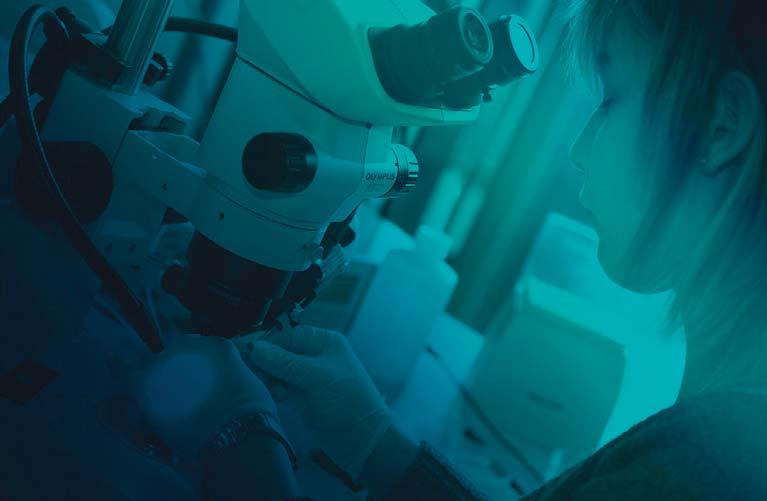Understanding the Nucleolus and Ribosomes at the service of biomedical innovation Interview with Pr Denis LAFONTAINE, Research Director at F.R.S./FNRS, RNA Molecular Biology laboratory & Lafontaine Lab, Université Libre de Bruxelles (ULB)
W
© Rights reserved
hat are the key figures and area of expertise of your laboratory? Created in 2001 at the ULB, my laboratory employs a dozen people and carries out several dozen research projects. It has to its credit ~80 scientific publications in internationally peer-reviewed journals accounting for >7,000 citations (h-index 41) as well as the training of some forty researchers of 15 nationalities. The area of expertise of my laboratory is RNA biology. Ribonucleic acids (RNAs) play fundamental roles in our cells, being part of essential nanomachines, they are also among the most ancient molecules dating from the prebiotic world.
What research partnerships have you developed? The laboratory is a member of several European academic consortia including RiboEurope, funded by the European Commission within the framework of the EJP RD (European Joint Programme on Rare Diseases). It also offers its expertise in the form of services or scientific collaborations to Belgian companies (GSK, Progenus, OncoDNA…).
Could you tell us about your spin-off project? Our spin-off project is based on the filing of a patent focused on the morphology of the nucleolus. The size, the shape, and the number of nucleoli per cell vary greatly in disease making them potent biomarkers for diagnostic or prognostic purposes, in particular for cancers, blood and brain diseases. The main market segment interested by our technology is Digital Pathology: a biopsy is taken from a patient and the nucleolus is observed under the microscope to find out whether it is normal or not, whether it reflects a disease state and at what level of severity the disease is. We have partnered with Prof. De Vleeschouwer at UCL (Université Catholique de Louvain) to develop a powerful software to analyze quantitatively the structure of the nucleolus. We have benefited from two funds from the Walloon Region (a FIRST Spin-off and a PoC - proof of concept) and are currently organizing a first fund raising with the help of Biopark Dev., Theodorus and SambreInvest. The company should be created in 2021.
Could you tell us about your main areas of research and give us some examples of current research projects? My team is interested to understand how ribosomes, the nanomachines inside our cells that produce all our proteins, are made and how the structure of the nucleolus (the cell’s ribosome factory) is organized and maintained. We are studying the diseases associated with the poor assembly of ribosomes. If ribosomes are in excess, they cause cancers because the excess protein stimulates the proliferation of cancerous cells. If they are in deficit or defective, they induce ribosome-related pathologies, the so-called ribosomopathies, affecting primarily the blood (haematopoiesis) and the brain (brain malformation, neurodegenerative diseases). As an example, we are studying Diamond-Blackfan anemia, a genetic disease that affects the production of red blood cells and makes patients dependent on weekly blood transfusions. In a collaborative effort, the study of the mutations underlying this pathology has enabled us to develop and test therapeutic vectors based on gene correction to restore normal ribosome production. We have also been involved in characterizing the impact of ribosome biogenesis dysfunction on leukoencephalopathy with calcification and cysts, a terrible brain disease and we hope our findings will soon translate into biomedical applications.
© LafontaineLab – ULB
What do you see as the main challenges ahead for molecular and cell biology research? The main challenge for us will be to integrate the concepts of soft matter and biophysics in biology. There is an urgent need to decompartmentalize research. In the September 2020 issue of Nature Reviews Molecular Cell Biology, we have developed the view that the nucleolus is a multiphase liquid condensate. Put simply, the nucleolus behaves like a liquid droplet inside our cells sharing many of the biophysical properties of immiscible liquids like “when oil and vinegar are mixed”. In fact, each cell comprises many such compartments or “droplets” that do not mix. The biophysics underlying the behavior of immiscible liquids will therefore be essential to understand how cells are organized and functionally compartmentalized.
a, The nucleolus (the ribosome cell’ factory) in a healthy (left) and diseased (right) cell (size range microns); b, The ribosome is the nanomachine inside our cells responsible for producing all our proteins (size range nanometers).
84
For more information: - Lab website www.LafontaineLab.Com; - Lab Twitter: @LafontaineLab - Denis L.J. Lafontaine, Joshua A. Riback, Rümeyza Bascetin, Clifford P. Brangwynne (2020) “The nucleolus as a multiphase liquid condensate” Nature Reviews Molecular Cell Biology DOI: 10.1038/s41580-020-0272-6.

















































































































